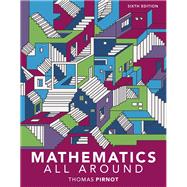For courses in liberal arts mathematics.
Given their widely varying backgrounds, students in Liberal Arts Math often enter the course with math anxiety. Pirnot’s Mathematics All Around offers the supportive and patient writing style that students need to overcome that apprehension, developing useful skills through realistic applications that can be seen in the world around them. Relevant and approachable, the author’s tone resembles the support students would receive during an instructor’s office hours. The author emphasizes a problem-solving approach, reinforcing problem-solving methods and how to apply them throughout the text. The 6th Edition keeps students engaged with updated real-world applications, while also providing more support as they learn with new measurable objectives, revised exercise sets, significant enhancements to each chapter, as well as a new student Workbook.
Also available with MyLab Math.
MyLab™ Math is an online homework, tutorial, and assessment program designed to work with this text to engage students and improve results. Within its structured environment, students practice what they learn, test their understanding, and engage with media resources to help them absorb course material and understand difficult concepts.
Note: You are purchasing a standalone product; MyLab™ does not come packaged with this content. Students, if interested in purchasing this title with MyLab, ask your instructor for the correct package ISBN and Course ID. Instructors, contact your Pearson representative for more information.
If you would like to purchase both the physical text and MyLab, search for:
0134468929 / 9780134468921 Mathematics All Around plus MyLab Math -- Access Card Package, 6/e
Package consists of:
- 0134434684 / 9780134434681 Mathematics All Around, 6/e
- 0321431308 / 9780321431301 MyLab Math -- Glue-in Access Card
- 0321654064 / 9780321654069 MyLab Math Inside Star Sticker








